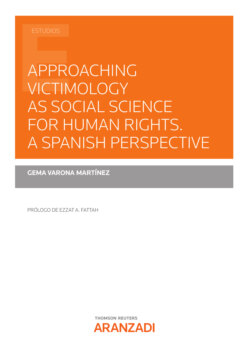Читать книгу Approaching Victimology as social science for Human rights a Spanish perspective - Gema Varona Martínez - Страница 27
5. REFERENCES
ОглавлениеAldington, C., Wallace, J. y Bilby, C. (2020). Out-casted/Re-casted; Towards a Lexicon for Restorative Artmaking and Co-creation. In Varona, G. (ed.). Arte en prisión. Justicia restaurativa a través de proyectos artísticos y narrativos (pp. 157-201). Valencia: Tirant lo Blanch.
Baca, E., Echeburúa, E. and Tamarit, J. M. (2006). Manual de victimología. Valencia: Tirant lo Blanch.
Braithwaite, J. (2020). Asking the domination question about justice. In Carlen, P. and Ayres, L. (eds.) Justice alternatives (pp. 19-26). London: Routledge.
Christie, N. (1986). The Ideal Victim. In E. A. Fattah (ed.) From Crime Policy to Victim Policy (pp. 17-30). London: Macmillan, 1986.
Cook, E. A. and Walklate, S. (2019). Excavating victim stories: Making sense of agency, suffering and redemption. In The Emerald handbook of narrative criminology, (pp. 239-257). Bingley: Emerald.
Duggan, M. (Ed.). (2018). Revisiting the’ideal Victim’: Developments in Critical Victimology. Policy Press.
Dussich, J. (2011). Psycho/Social Coping. A Theoretical Model For Understanding General Victimisation and Facilitating Recovery. Presentation for the 11th Asian Post Graduate Course on Victimology and Victim Assistance, Jakarta, Indonesia July 2011.
Echeburúa, E. y Cruz, M. S. (2015). De ser víctimas a dejar de serlo: un largo proceso. Revista de Victimología/Journal of Victimology, (1), 83-96.
Elias, R. (1986). The Politics of Victimisation:Victims,Victimology, and Human Rights. New York: Oxford University.
Fattah, E. A. (1991). Understanding Criminal Victimisation. Scarborough: Ontario.
Feyter, K. de et al. (eds) (2006). Out of the ashes. Reparation for victims of gross and systematic human rights violations. Antwerpen: lntersentia.
Galona, Y. (2018). From ritual to metaphor: The semantic shift in the concept of ‘victim’and medieval Christian piety. International Review of Victimology, 24(1), 83-98.
Haslam, N. (2016). “Concept creep: Psychology’s expanding concepts of harm and pathology.” Psychological Inquiry, 27, p. 1-17.
Karmen, A. (2013). Crime victims: An introduction to Victimology. Cengage Learning (online).
Lauritsen, J. L., & Rezey, M. L. (2018). Victimisation trends and correlates: Macro– and microinfluences and new directions for research. Annual Review of Criminology, 1(1), 103–121. https://doi.org/10.1146/annurev-criminol-032317-092202
Miller, C. (2020). Know my name: A memoir. London: Penguin Books.
Pemberton, A. (2020). A Theory of Injustice and Victims’ Participation in Criminal Processes. In Victimology (pp. 359-379). Cham: Palgrave Macmillan.
Reyes Mate, M. (2011). Tratado de la injusticia. Barcelona: Anthropos.
Romero-Sánchez, M., Skowronski, M., Bohner, G. and Megías, J. (2021) Talking about ‘victims’, ‘survivors’ and ‘battered women’: how labels affect the perception of women who have experienced intimate partner violence, International Journal of Social Psychology, 36:1, 30-60.
Schur, E. M. (1965). Crimes without victims: Deviant behavior and public policy: Abortion, homosexuality, drug addiction (pp. 1-8). Englewood Cliffs, NJ: Prentice-Hall.
Shklar, J. (1990). The Faces of Injustice. New Haven: Yale University Press.
Spencer, D. C. and Walklate, S. (eds.) (2016). Reconceptualizing critical Victimology. Interventions and possibilities. New York: Lexington.
Strobl, R. (2004). Constructing the victim: Theoretical reflections and empirical examples. International Review of Victimology, 11(2-3), 295-311.
Substance Abuse and Mental Health Services Administration. SAMHSA’s Concept of Trauma and Guidance for a Trauma-Informed Approach. HHS Publication No. (SMA) 14-4884. Rockville, MD: Substance Abuse and Mental Health Services Administration, 2014.
Tombs, S. (2018). For Pragmatism and Politics: Crime, Social Harm and Zemiology. In Boukli, A. and J. Kotzé (eds.), Zemiology, Critical Criminological Perspectives, https://doi.org/10.1007/978-3-319-76312-5_2.
Van Dijk, J. (2020). Victim Labeling Theory; A Reappraisal. In An International Perspective on Contemporary Developments in Victimology (pp. 73-90). Cham: Springer.
Van Dijk, J. (2008). In the shadow of Christ? On the use of the word “victim” for those affected by crime, Criminal Justice Ethics, 27:1, 13-24, DOI: 10.1080/0731129X.2008.99922241
Varona, G. (2021, in press). Reframing the notion of violence in macro-victimisation and abuse of power to embrace the cultural dimensions of victimhood. In Zamora, J. A.
Wiedlitzka, S. (2020). Risk Factors for Victimisation and the Impact of Victim Status on Perceptions of Police Legitimacy in Australia. Victims & Offenders, 1-22.
1.As van Dijk (2008, p. 13) explains, this is not only the etymological meaning in Romance languages, but also in other languages: “In German, for instance, the victim is called Das Opfer, meaning the sacrifice; and in Swedish, Brottsoffer, the sacrifice of the crime. In Icelandic the word used for victim is Foernarlamb, meaning the sacrificial lamb. In Dutch the word is slachtoffer. The Dutch term means, literally, the butchered, sacrificial object. The identification of crime victims with sacrificial objects is not limited to English, Romance, or Germanic languages. In Russian (zherta), Hungarian (aldozot), and modern Greek (tema), to name just a few, crime victims are also referred to as sacrificial objects”. This seems to happen too in Hebrew and Arabic languages, but it does not happen in other languages such as Chinese or Japanese.
2.See the complete quoted references in that work.
3.See paragraph 38 of the Preamble and Article 22 of the Directive 2012/29/UE. See also art. 22.4 of the Spanish criminal code.
4.Nick Haslam (2016) coined the idea of “concept creep” to help understand the expansion in the general use of some concepts coming from Psychology (abuse/neglect; bullying; trauma; mental disorder; addiction; and prejudice) that might bring an increasing sensitivity to harm with diverse effects in society.
5.See at https://tacklinghate.org/trainingmodule/helping-victims-to-report-hate-crimes-best-practice-guidance-for-agencies-that-receive-victims-reports/.
